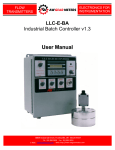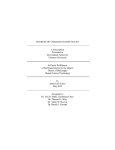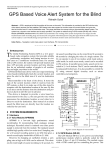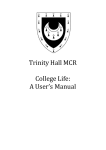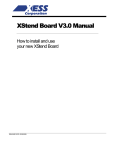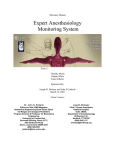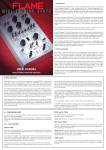Download Alternative Design 1 - BME - University of Connecticut
Transcript
Alternative Design #1 Accessible Home Vital Signs Monitor Team #3 Robert Croce, Jenna Sullivan, Mike Kapinos Project For RERC National Design Competition Client Contact Dr. John Enderle Director and Professor of Biomedical Engineering Program University of Connecticut Bronwell Building 260 Glenbrook Road Storrs, CT 06269-2247 Phone: (860) 486-5521, FAX: (860) 486-2500, email: [email protected] Introduction Due to the increasing number of chronic illnesses, along with the shortage of nurses, home monitoring is becoming more and more of a necessity. Patients that require frequent healthcare monitoring can now have this done in the comfort of their own home. An important tool for home health monitoring is the vital signs monitor. Our accessible home vital signs monitoring system will have the capability to non-invasively gather a patient’s heart rate, blood pressure, blood oxygen level, and body temperature, and then send this data to their corresponding healthcare provider. To send this data, we will create a password protected encrypted website to which patients can upload their vital signs. This accessible home vital signs monitoring system design is an accurate and consistent way to obtain a patient’s vital signs, regardless of the caregiver’s skill level. To accommodate all users, including our clients, the monitoring system was designed as simple and user friendly as possible. Our three clients that are in need of an accessible home vital signs monitoring system are Mat, Sani, and Dolores. Mat is a blind 52-year-old male who just had a small stroke and lives with his vision-impaired wife, who loves the internet. Sani is a 31-yearold female who recently experienced a head injury from an automobile accident. This accident left the right side of her body paralyzed (her dominant side). Her doctor monitors her vital signs by a computer system that is installed in her home, but she does not want to appear sick to her family and friends. She would like a vital signs monitoring device that blends in with the other furniture in her home. Our last client is Dolores. She is an 86-year-old female who lives with her son, his wife, and their son. Dolores is deaf and has severe arthritis. She also has heart problems that cause her to receive infusions at home. These infusions are normally administered by one of her family members. Dolores’ grandson Tyler is 11 years old, and he likes all kinds of electrical gadgets. He loves to help his grandmother collect her vital signs and send them to her doctors on the computer. To maximize the simplicity of our design and make it accessible to our clients, the buttons on the front panel of the monitor will be large and printed with either Braille or a universal symbol, allowing patients who are vision-impaired or have arthritis to successfully operate the monitor. Also to accommodate vision-impaired clients, a textto-speech function will be implemented to allow the monitor to audibly tell the patients what their current vital signs are. In addition, four bright LCD screens with wide viewing angles will be used to display the patients’ vital signs. A visual and audio alarm will be installed to alert clients if their vital signs are abnormal. To collect the data, medical transducers will be commercially purchased and integrated into the accessible vital signs monitoring system. The items to be purchased are a finger pulse oximeter probe, an oral temperature probe, and an automatic blood pressure cuff. Below is an illustration of our design as well as a flowchart of our system operation. 1 Figure A Figure 1: Illustration of Design 3" Handle Alarm 2" 2" Blood Oxygen Level Heart rate 65 BPM 100 8" Blood Pressure 1" Body Temperature 98.6 ° F 120/180 1" Record 2/3" BP 10" Speaker Figure 2: Flowchart of accessible vital signs monitor operation 2 Thermometer To measure body temperature, a thermistor circuit will be used. The thermistor will be in the form of a commercially purchased, oral temperature probe (brand to be determined) (Fig. 3). http://www.dremed.com/catalog/product_info.php/products_id/1214 Figure 3. Oral Temperature Probe It will convert changes in temperature to changes in voltage. Unfortunately, thermistors are inherently non-linear. The Steinhart-Hart equation describes the resistancetemperature curve of a thermistor [10]: 1 = a + b ln( R ) + c ln 3 ( R) T where T is the temperature in kelvins, R is the resistance in ohms, and a, b, and c are constants called the Steinhart-Hart parameters. To linearize the output of the thermistor, it is placed in series with a resistor [2]. The value of the resistor will be determined from the resistance of the thermistor at room temperature and data from the temperature probe spec sheet. For our use as an oral temperature probe, the thermistor needs to be linearized for temperatures from 90-104° F (32-40°C). It is important that we maintain the precision of the thermometer in order to make appropriate measurements. After being linearized, the signal will be sent to a low-pass filter to filter out any noise (cutoff 1 ). The signal will be sent to a non-inverting amplifier to be frequency, f c = 2πR2 C amplifier and then passed to the microprocessor where it will be analyzed and sent to an LCD screen to be displayed (Fig. 4). 3 C R1 R2 U1 + OUT - OPAMP RT1 THERMISTOR t R3 R4 0 Figure 4. Thermometer Circuit Pulse Oximeter To measure blood oxygen saturation, a pulse oximeter will be used. Pulse oximetry uses the optical properties of blood to determine oxygen saturation. Blood oxygen saturation (SpO2) is defined as the ratio of oxyhemoglobin (HbO2) to the total concentration of hemoglobin in the blood (Hb + HbO2): SpO 2 = [HbO 2 ] [Hb + HbO 2 ] . This can be determined by measuring the difference in the light absorption spectra of oxyhemoglobin and deoxyhemoglobin [9]. Assuming that the transmission of light through the arterial bed in the finger is only influenced by the concentrations of Hb and HbO2 and their absorption coefficients at two measurement wavelengths (red and near infrared), then the light intensity will follow the Beer-Lambert Law. Thus, for an artery of length l, through which light of intensity Iin passes: I 1 = I in110 − (α o1Co +α r 1Cr ) l at wavelength λ1, and I 2 = I in 2 10 − (α o 2Co +α r 2Cr ) l at wavelength λ2, where Co is the concentration of HbO2, Cr is the concentration of Hb, αon is the absorption coefficient of HbO2 at wavelength λn, , and αrn is the absorption coefficient of Hb at wavelength λn. Therefore, if I ⎞ log⎛⎜ 1 ⎟ ⎝ I in1 ⎠ , R= I2 ⎛ ⎞ log⎜ ⎟ ⎝ I in 2 ⎠ " " then blood oxygen saturation can be calculated from 4 SpO 2 = Co α r 2 R − α r1 = . C o + C r (α r 2 − α o 2 )R − (α r1 − α 01 ) Circuit Design The block diagram of the pulse oximeter below shows the circuits that are involved and will be included in the vital signs monitoring device (Fig. 5) Figure 5. Pulse Oximeter Circuit Block Diagram The finger probe for the pulse oximeter will be commercially purchased (brand to be determined) (Fig. 6). http://www.dremed.com/catalog/product_info.php/cPath/205_210/products_id/435 5 Figure 6. Pulse Oximeter Finger Probe It will contain two LEDs, one that works at a red wavelength and the other at a nearinfrared (NIR) wavelength. Also, in the probe will be a photodetector that will detect the light transmitted through the finger. The red LEDs used in the probe have been manufactured to give high intensity output, and the NIR LEDs are designed to be pulsed so that their peak power can be increased without increasing their average power. By pulsing both light sources, only one photodiode is needed to detect the light transmitted through the finger [9]. To transmit light, the LEDs need to be driven by a constant current source. This can be done by a non-inverting op amp combined with a FET (Fig. 7). R OUT + U1 0 Figure 7. Circuit for constant current LED driver To control the pulsing of the LEDs, timing circuits need to be used. For this, we will use 555 timer circuits (Fig. 8). +Vcc R1 R2 8 VCC TRIGGER RESET OUTPUT CONTROL THRESHOLD DISCHARGE GND 555B 1 10n 2 4 5 6 7 C2 0 0 3 0 Figure 8. Timing circuit 6 Finally, an n-channel enhancement-mode MOSFET connected across the each LED is used to pulse the output from them (Fig. 9). R1 OPAMP - OUT + 0 DS135C Figure 9. Circuit to pulse the LEDs In the receiving end of the circuit is the photodetector. The photodetector used in pulse oximetry probes is a photodiode. The photodiode detects the light transmitted through the finger as current [9]. To amplify the signal, the photocurrent must be converted into a voltage with moderate output impedance. This can be done by using an op-amp configured for current-to-voltage conversion (Fig. 10). C R + D4 OUT - V 0 Vo OPAMP V Figure 10. Current to voltage photodiode conversion circuit Because the LED light is pulsed, sample-and-hold circuits are needed to reconstitute the waveforms at each of the two wavelengths. The timing circuits that were used to control the red and NIR LED drivers also are used to provide the control pulses for their corresponding sample-and-hold circuits [9]. A simple sample-and-hold circuit can be created from a FET switch, capacitor, and op amp (Fig. 11). 7 - OPAMP OUT + U3 M4 C3 1n M2N6806 0 Figure 11. Sample-and-hold circuit Once the signal goes through the sample-and-hold circuit, it is sent through a band pass filter to eliminate noise, then amplified and sent through an A/D converter \the microprocessor to be analyzed. A lookup table stored in the microprocessor will be used to calculate SpO2 values. This signal is also sent through a low pass filter to extract the d.c. value of the transmitted signal which is then sent to an automatic gain control circuit. The gain control circuit adjusts the light intensity from the LEDs so that the d.c. level always remains at the same value, whatever the thickness of the patient’s skin, tissue, etc. This circuit is implemented by feeding the d.c. signal to one input of a differential amplifier. The other input to the amplifier is a constant reference voltage. The output of the differential amplifier, the voltage difference between the two inputs, is used to generate the voltage that sets the value of the LED currents [9]. Heart Rate Pulse oximetry will also be used to determine heart rate. There are pulsatile signals detected in the intensity of the detected light by the photodiode (Fig. 12). Figure 12. Pulsatile signals found in the intensity of detected light [9]. These pulses can be counted within a given time period to determine heart rate. This will be done by the microprocessor and displayed on an LCD screen. Non Invasive Blood Pressure 8 One way in which blood pressure can be measured non-invasively is through use of an occlusive cuff. The cuff is wrapped around the upper arm and inflated until the pressure around the arm due to the cuff collapses (or occludes) the brachial artery. Then the cuff is slowly deflated. As the cuff is deflated, Korotkoff sounds can be heard from the artery. The pressures at which these sounds are heard determine systolic and diastolic pressures [3]. Automated blood pressure measurement includes two systems: the cuff control system and the microphone system to measure the Korotkoff sounds generated. The cuff control system involves inflating the cuff then deflating it at a slow rate to produce the Korotkoff sounds. A complex circuit is used to detect the Korotkoff sounds. The circuit must differentiate between the Korotkoff sounds, background noise, and the heart beating. It also must determine which phase a sound implies [8]. To measure blood pressure, an automated system will be used that measures Korotkoff sounds. Due to the complexity of the automated system, a commercially purchased system, such as the Omcron Automatic Blood Pressure Monitor, will be purchased and integrated in our vital signs monitor. The resulting measurement for blood pressure will be displayed on an LCD screen on the front of the vital signs monitor. Microprocessor The microcontroller we have chosen for the data input and visual/audio output is the Microchip PIC16877F, which is shown below. This microcontroller is ideal for our design because it will allow us to connect multiple LCD screens to a single microchip. This is will not only save us money, but it will also reduce the amount of space it takes up by adding multiple microcontrollers for each monitor. It also contains 5 I/O ports which will serve as inputs for the transducers collecting the vital signs. This microcontroller will be used to display the vital signs recorded via the four character LCD screens. To do this we will first connect one LCD monitor to the serial output pin (TX #17), then use the USTART transmit function to communicate with the LCD screens. To connect additional screens, they will need to be hooked up to pins 15, 16, and 17 (RC0, RC1, RC2). These pins will have to be configured as an output. The programming for communicating between the LCD screens and the microcontroller will be done using MPLAB software coded in assembly language, which is readily available for use in our design lab. Input to the microcontroller will have to be between 2 and 5.5V. Also contained in this microcontroller is an analog to digital converter, which will be used to convert the input data from the transducers. After the A/D conversion is complete, this data will be stored in the ADRESH:ADRESL register [5]. 9 Figure 13: PIC16F877 Pin Diagram http://www.rentron.com/images/snap5.gif Figure 14: PIC16F877 Features Key Features PICmicro Operating Frequency RESETS (and Delays) FLASH Program Memory (14-bit words) Data Memory (bytes) EEPROM Data memory Interrupts I/O Ports Timers Capture/Compare/PWM Modules Serial Communications Parallel Communications 10-bit Analog-to-Digital Module Instruction Set PIC16F877 DC - 20 MHz POR, BOR (PWRT, OST) 8K 368 256 14 Ports A, B, C, D, E 3 2 MSSP, USART PSP 8 input channels 35 instructions 10 LCD Screens: The digital information from the output of the microcontroller will be sent to four character LCD screens shown below. Figure 15: LCD Screen http://www.crystalfontz.com/products/1601a-color/thumb_CFAH1601A-GGH-JP.jpg The CFAH1601A-GGH-JP LCD screens are ideal for our design due to its easy to read characters, ideal size, and wide viewing angles. It measures 80mm x 36mm with a viewing area of 66mm x 16mm, and a character height of 6.56mm. These LCD screens were chosen due to the fact that many of the features meet the specific needs of our clients. Since the majority of our clients will be viewing the monitor from their bed, it is important that the screens should be viewable from a wide variety of angles. Since these screens have a wide viewing angle, patients will have no problem seeing their vital signs from their bed. Also, the green backlight makes this LCD screen easy to read, especially in dark or dim-lighted areas. Speech Output: Our vital signs monitor will contain a text-to-speech function which will allow the monitor to say what the vital signs are once they have been recorded. This function will be useful for our client Mat, who is blind and cannot see the monitor. Even though his wife is around to help him, she is also vision-impaired. The output text from each pin on the microcontroller will need to be converted to sound. To do this, we will use the Magnevation SpeakJet IC. It is an 18 pin IC which uses a mathematical sound algorithm to control an internal five channel sound synthesizer to produce sound. The SpeakJet can be controlled by a single I/O line from our PIC16877F Microcontroller [6]. Since this microchip requires phonetics and not text, the TTS256 Text to Code IC will have to be used in conjunction with the SpeakJet. The TTS256 is an 8-bit microprocessor programmed with letter-to-sound rules. This built-in algorithm allows for the automatic real-time translation of English ASCII characters into allophone addresses compatible with the Magnevation SpeakJet Speech Synthesizer IC. This IC is Compatible with Basic Stamp, OOPic, Pic and any processor with a serial port, like our microchip [6]. We will 11 use pin #5 (TX) to output the phonetics to the SpeakJet, and pin #18 (RX) to receive the data from the PIC16F877 microcontroller. The pin diagram of the TTS256 is shown below. The final sound will be sent from the Voice Output pin (#18) of the SpeakJet using +5V and a speaker. Since the SpeakJet is preconfigured with 72 speech elements, 43 sound effects, and 12 DTMF touch tones, we will also use the SpeakJet to produce an alarm when the vital signs are out of range (range to be determined). Figure 16: SpeakJet IC http://www.speechchips.com/images/SpeakJetIC.jpg Figure 17: Pin Diagram of TTS256 http://www.speechchips.com/images/tts256.gif 12 To play these computer generated sounds, a speaker from Futurelec will be purchased and attached to the microcontroller. This speaker was chosen due to its small size and affordable price. This speaker will be used to play the data output from the microcontroller, as well as sound an alarm when the patients’ vital signs become irregular. Figure 18: Small Speaker for Audio Output http://www.futurlec.com/Pictures/Sm_Speaker.jpg Features • Small Size • Power rating: 0.5W • Impedance: 8 ohm • Dimensions: 50mm Diameter, 16mm High, 28mm base diameter Alarm To assist our clients, we will install an alarm system to alert them when their vital signs have become irregular or dangerous. On top of the monitor will sit a light that will flash when these signs become abnormal. A light we have chosen is shown below. In addition, an alarm sound generated by the SpeakJet will also serve as an alert. The majority of the alarm design will be done by programming the microprocessor. We will have a set of defined limits for each vital sign, and if these signs fall out of range, a signal from the microcontroller will be sent to the SpeakJet and alarm light. 13 Figure 19: Alarm Light http://img.alibaba.com/photo/50538513/Alarm_Lights__Warning_Lights_.jpg USB Device: The USB device is a very important part to include in this project. The main job of the USB device is to store the readings taken by the machine. This device will then be connected to a computer in which it is possible to send the readings to any computer that has an internet connection. The USB device that we decided to use is the Philips. PDIUSBD11. This device uses I2C technology to be able to connect to the microcontroller. This allows for easy communication between the two. By writing a computer program in the microcontroller we will be able to send the data received by the machine to the USB device and then to the computer. The following image shows the schematic of a how the USB device will connect with the microcontroller. 14 Figure 20: USB Schematic Power Supply: When designing this project we found it rather important to include two different types of power. The device will mainly be run from an external power source by using a power cord. It will also be equipped with rechargeable backup batteries in case of a power failure. For the power supply we plan on using a very generic universal power cord which will plug into the back of our device and then also plug into the wall. For the backup power supply we determined the best way would be to use nickel cadmium rechargeable batteries. Although lead acid batteries can sometimes produce more voltage, nickel cadmium batteries are safer and will recharge a lot quicker. The need for a backup battery is so the patient can take signs even if the power is gone. Also if power is lost that means the alarm will also be shut off causing the patient to possibly miss a time. This could be life threatening to some patients so we felt it was very important to include a backup supply. 15 Figure 21: Image of rechargeable battery Secure Website After the patients vital signs have been gathered and recorded, they need to be sent to their primary healthcare provider. To maximize patient privacy we have devised a way to securely transmit the patients’ health information, minimizing the risk of interception. We will create an encrypted, password protected website to which the patient uploads the information from their USB stick. To ensure that the website is secure, HTML encryption software will be used to encrypt the contents of the website, allowing only those with the correct username and password to access it. We will use encryption software such as TagsLock Pro v 2.22 to hide the source code of our HTML documents. To encrypt HTML using TagsLock PRO, you need to create a new project once, and re-use it later when the site content gets modified and needs re-uploading. In order to use this encryption software, a website using the UCONN Biomedical Engineering server will have to be created. Realistic Constraints The main source for medical instrumentation standards is the Association for the Advancement of Medical Instrumentation (AAMI). They provide for purchase the current standards of medical device design and use. These standards must be followed in the design and production of our device to ensure that it is acceptable and safe for our clients and the health care community. This device has been designed with the economic constraint of cost in mind. We have a maximum budget of $2000 to build a working prototype of our device, so parts were chosen carefully. A balance had to be maintained between using parts that meet the needs of our design and not overspending our budget. It may be especially important to have room left in our budget next semester when we begin the actual construction of our device. We may need to order replacement parts or additional parts as we go and we cannot do that if we have no money left within our budget. Our accessible home vital signs monitor is meant for use in the home, so varying environmental conditions are not a large concern of the device. However, being used in the home, there were a few things we needed to keep in mind as we made our design. 16 Our device will be exposed to dust, sunlight, food, and water. Though it is not meant to withstand an onslaught of any of these things, it was designed to be relatively robust in these conditions. No parts were used that are very sensitive to movement or other household factors that could affect their use. The device will have a durable plastic casing and has been designed to withstand short falls (<5feet) and mild wetting (dripping water). It was designed with the typical rigors of home electronic life in mind so that it may withstand these challenges (movement, animals, children, cleaning, spills, etc.). That being said, the device is not a toy, nor was it designed to be one, and the user should keep in mind the device’s purpose when using it. There are little to no concerns over our device’s effect on the environment. As it is a piece of home electronics, it has very little effect on the environment as a whole. Offshoots of the environmental constraints laid on our device are the accessibility constraints that it needs to meet. Our device was designed to be properly accessible so that it will be of use to our clients and meet their needs. Audio and visual output, along with Braille and raised universal symbols were used to make the device user friendly to anyone with vision or hearing impairment. Also, the simple user interface of the device allows it to be used by individuals of all ages and technological savvy. This leads into sustainability. Our device was designed with its ability for future and continued use in mind. Not only must the device be designed so that it can last and function properly for years, but it also needs to use up-to-date parts and technology so that it does not become outmoded. An example of this was the selection of the rechargeable battery for our device. In many vital signs monitors being used, rechargeable lead batteries power the device. However, lead materials are currently being phased out of medical devices so we chose to use a nickel cadmium rechargeable battery in our design. This is one step that was taken to ensure that our device will still be acceptable for use years from now. Because this is a medical device and will have direct contact with our clients, client/patient safety was an important constraint in our design process. All circuits and power sources must be properly grounded to prevent accidental electrocution and safety measures had to be put in place to prevent an injury use of the device might cause. Most components of our design are relatively benign (provided that basic electrical safety is followed), but a major point of health and safety constraint was the design and incorporation of the automatic blood pressure measuring device. Self-inflating blood pressure cuffs can cause injury if not properly calibrated and used (fig.) 17 Figure 22: Bruising caused by one use of an automatic blood pressure cuff [8]. Bruising can result if the cuff inflates too much. Pain and circulation cutoff can occur if the cuff does not deflate, and at the extreme this could lead to tissue death. Our accessible vitals signs monitoring system has really no political constraints, but it does have social and privacy constraints. Part of our system includes the transmission of vitals signs of the internet to a health care provider. To protect patient privacy and abide by the Health Insurance Portability and Accountability Act (HIPAA), the transmission of vital signs will be done via a secure, password protected website. This will protect our clients’ personal information while still giving them flexibility in the transmission of their vital signs to their physicians or HMOs. This is an important and valid constraint in our device design. The internet provides rapid transfer of information, but it is filled with predators and opportunists who like to access the private information of others. It is important for us to protect our clients when they are contacting their physicians so that their medical information does not end up all over the World Wide Web. By paying heed to these constraints and working with them, not around them, our accessible home vital signs monitoring system has been designed with the best interests of our clients and society at heart. This ensures that we have designed an economically feasible device, affordable for our clients. Our device is appropriately designed for the environment which it will be used in, and with careful part selection it will sustain and continue to be appropriate for the home monitoring of vital signs. Safety Issues Safety plays a crucial role when designing a product, especially one that contains electrical components. Because our design will be comprised mainly of electrical 18 components, we strive to effectively enclose the inner circuit of our final design with a durable, non-conductive, completely enclosed casing. The casing of our final design will show no wires, circuit boards, or any part of the inner circuitry. Loose wires will have the potential to not only cause the device to operate ineffectively, but could also be hazardous to the patient. Any moisture from the air, or water accidentally spilled near the device, could cause a spark and start a small fire. It is for this reason that it will be recommended that all liquids be kept off of and way from the monitor, regardless of how good the casing. Also, it is important for the casing to be made of a non-conductive material (such as plastic), so that if the “hot” side of the power system touches the side of a casing, there is no danger to the user of the monitor. The inner part of the monitor should be designed so that neither the “hot” or “neutral” part of the power cord touches the casing, but if the “hot” wire does accidentally touch the casing, then this could be dangerous. If the casing is conductive and the “hot” wire touches the side of the case, then the case will be made electrically common to the wire, and touching the case will be just as hazardous as touching the wire bare. In addition, it is always important for an electrical design to have a solid connection to earth ground. A power system with no secure connection to earth ground could pose a safety hazard. There is no way to guarantee how much or how little voltage will exist between any point in the circuit and earth ground. By grounding one side of the power system's voltage source, at least one point in the circuit can be assured to present no shock hazard. One way to ensure proper ground is to use a three prong plug. The third prong on the power cord provides a direct electrical connection from the appliance case to earth ground, making the two points electrically common with each other. If they're electrically common, then there cannot be any voltage dropped between them. Even if the “hot” wire accidentally touches the metal casing, it will create a direct shortcircuit back to the voltage source through the ground wire. Choosing the correct gauge wire is also an important factor to consider. An electrical hazard exists when the wire is too small a gauge for the current it will carry. If a wire is too small for the current it is supposed to carry, the wire will heat up. The heated wire could have the potential to cause a fire inside the monitor. After selecting the correct wire gauge, it is important to make sure that all wires are properly insulated and cleanly soldered to its respective position on the circuit board. Frayed wires have the potential to interact with other wires causing the monitor to not work properly or cause a fire. In addition to the electrical safety issues, it was also made sure that the operator of the monitor does no harm to the patient while taking measurements. Each instrument used to obtain measurements was carefully chosen to be as simple and safe as possible. Out of the four vital signs being obtained, the only one which needs skill to operate would be blood pressure. Using the blood pressure cuff incorrectly could not only cause the monitor to record the wrong vital signs, but also harm the patient. Squeezing the blood pressure cuff too tightly could injure the patient. To minimize this potential hazard, we will use an automatic blood pressure cuff, allowing the person who is taking the readings to have no prior skill. Since the people taking the vital sign readings are elderly or young, the automatic blood pressure cuff makes gathering data relatively simple. Even though the automatic blood pressure cuff is simple to use, it is still not completely foolproof. 19 Impact of Engineering Solutions Much of the technology used in our design for an accessible home vital signs monitoring system is not new, but the manner in which it is being employed is valuable. There are few, if any, accessible vital sign monitors currently available. Patent and web searches have not devices on the market comparable in that regard to the device that we have designed. The design of an accessible vital signs monitor will improve the quality of life for those individuals with hearing and vision impairment who need to have their vital signs monitored. This device will allow those individuals the ability to go home to recuperate while still being effectively monitored by their health care provider. This is especially important in cases where home health care would be a treatment option for someone without visual or hearing impairments but not for someone with them. Home health care is a growing industry. Approximately 7.6 million individuals receive home care in the United States. The Center for Disease Control reported that in the United States in 2000, 317,600 individuals in home care were using medical devices (Fig. 21) Figure 23. Excerpt from Table of Number of Current Home Heath Care Patients with Aides and Devices in 2000 [4]. As such, it is important to have reliable technology to support home care. Home care can not only save patients and insurance companies money (Fig. 22), but living at home can provide patients a welcome and comfortable environment in which to recover and be monitored. 20 Figure 24. Table of Home Care Cost Savings [1]. When patients choose (or have the option) to enter home care, they free up hospital beds for more acute cases, give doctors more time to work with sicker people, and many times patients they are happier at home than in the hospital. But patients can not be cared for at home unless they have the proper technology to do so. Our accessible vital signs monitoring device is a simple, easy-to-use method to monitor patients’ health at home. It can be operated by patients, their families, and physicians, making it an ideal device for the home environment. Since vitals signs are saved on a USB flashdrive to be uploaded to a secure website, patients are not even stuck at home, but can take their rechargeable battery powered vital signs monitor with them if they need to monitor their vital signs. This offers flexibility and comfort to patients. Economically, the design for our device will reduce some of the costs of healthcare. Vitals sign monitors (and many of these are not accessible) currently range in cost from $2500 up to $5000. Most of the monitors that measure the same four vitals signs as our device (heart rate, blood oxygen saturation, blood pressure, and temperature) cost closer to $5000. If a patient’s health insurance will not cover this cost than it becomes a large out-of-pocket expense for them, or they may not be able to afford the device at all. This is detrimental to their health and recovery. By designing a monitor that’s expected cost is $700 (a third of the cost of the cheapest monitors currently 21 available), we will be able to alleviate some of this financial stress and provide more comprehensive health care and monitoring to more people. Globally, this design may translate into an affordable piece of medical equipment for undeveloped countries. With its two-button user interface, detachable transducers, and simple design, it may be useful in countries with a low level of technology. Our device is designed for home use, but in countries and areas with poor healthcare systems and little to no medical equipment, it would be useful in a hospital or emergency room. Because it is lightweight and has a rechargeable battery, and because vital signs are saved onto a USB flashdrive, our accessible vital signs monitoring system is an excellent option for remotely monitoring patients in areas where there are few trained medical personnel. A layperson (with no medical training) could use our device to visit a patient who does not have access to a hospital or doctor and record their vitals signs on a USB flashdrive. These measurements could then be uploaded to the secure website and accessed by doctors anywhere. Life Long Learning During the research of this design, we were introduced to new and challenging engineering applications. We were introduced to the inner workings of the microprocessor and how important it is to the majority of computer and electrical based designs. Even though we have had experience using microprocessors, this was a great opportunity to research and select the appropriate microcontroller that would be useful to our particular design. Parameters we needed to consider included the number of I/O ports, voltage range, and if it had an A/D converter. As we continue with the design, we will have the opportunity to use the microcontroller in a real life situation. Programming the microprocessor will be a challenge, since we have to code it do meet our specific needs. Also, the text-to-speech function in our design was a new and exciting function to learn about. Since none of us have ever worked with such a unique and advanced tool, it made the research enjoyable and informative. There are many devices out there used for speech synthesis, but we needed to find the one that would be compatible with the microcontroller we selected, as well as capable of converting the text output from the microcontroller to sound. Most algorithms associated with speech chips cannot convert English text straight to audio, which is why we integrated the TTS256 Text to Code microcontroller to convert text to phonetics, which is compatible with the SpeakJet. Through designing the thermometer for the accessible vital signs monitor, we have learned about the Steinhart-Hart equation and the properties of thermistors. It is important to realize that thermistors behave nonlinearly and to understand what effects this has on designing a thermometer. In order to use the thermistor output, it must be linearized. This can be done over a small temperature range, but any readings outside the temperature range will be increasingly inaccurate the farther away they are. This means that one should only use an oral thermometer to measure oral body temperature, not air temperature or a cold beverage. We learned about the optical properties of blood and the Beer-Lambert law to design a pulse oximeter circuit. Also from the pulse oximeter, we saw the application of transistors to switching and timing. Research into an automated blood pressure 22 measurement system highlighted the importance of control systems in medical devices. Even for something as seemingly benign as an automatic blood pressure cuff system, safety precautions have to be taken to ensure that a patient is not harmed through the use of the device. 23 References [1] “Basic Statistics About Home Health Care.” National Association for Home Care & Hospice.” 2004. <http://www.nahc.org/04HC_Stats.pdf>. [2] “Lineared NTC Thermistor.” eCircuit Center, 2002. <http://www.ecircuitcenter.com/ Circuits/therm_ckt1/therm_ckt1.htm>. [3] Northrop, Robert B. Noninvasive Instrumentation and Measurements in Medical Diagnosis. New York: CRC Press, 2002. [4] “Number of current home health care patients, by type of aids, devices used, sex, and race: United States, 2000.” Current Home Care Patients. Feb. 2004. <http://www. cdc.gov/nchs/data/nhhcsd/curhomecare00.pdf>. [5] PIC16F877 Data Sheet. Microchip Technology, 2001. <http://ww1.microchip.com/ downloads/en/DeviceDoc/30292c.pdf>. [6] SpeakJet User’s Manual. Magnivation, 2004. <http://www.speechchips.com/ downloads/speakjetusermanual.pdf>. [7] “Safe Circuit Design”. All About Electric Circuits, 2003. <http://72.14.209.104 /search?q=cache:HYM2hyPm4rcJ:www.allaboutcircuits.com/vol_1/chpt_3/8.html +circuit+design+safety&hl=en&gl=us&ct=clnk&cd=1>. [8] Townsend, Neil. “Non Invasive Blood Pressure.” Medical Electronics, Michaelmas Term 2001. <http://www.robots.ox.ac.uk/~neil/teaching/lectures/med_elec /notes7.pdf>. [9] Townsend, Neil. “Pulse Oximetry.” Medical Electronics, Michaelmas Term 2001. <http://www.robots.ox.ac.uk/~neil/teaching/lectures/med_elec/notes6.pdf>. [10] Volk, Karl R. “Using thermistors in temperature-tracking power supplies.” EDN. August 2, 2001. < http://www.edn.com/article/CA149117.html>. 24






























